What is the ESRF?
The ESRF – the European Synchrotron, located in Grenoble, France – is the world’s most intense X-ray source for scientific research. Founded in 1988, the ESRF is funded by 22 partner countries.
Each year, 10,000 scientists from all over the world come to the ESRF to probe the structure of matter in all fields of research, ranging from the chemistry and physics of materials to archaeology and cultural heritage, together with structural biology applications, environmental sciences and information science and nanotechnologies.
What is the EBS?
The ESRF’s Extremely Brilliant Source (EBS) is a 150M€ upgrade programme over 2015-2022 to construct and deliver
the world’s first high-energy fourth-generation synchrotron light source, open to users in 2020.
This blog follows the progress of the project, which includes:
– The construction of a revolutionary new storage ring
– State-of-the-art new beamlines
– An advanced instrumentation programme
– An ambitious ‘data-as-a-service’ strategy
What does EBS mean for X-ray science?
The new storage ring, together with the most advanced portfolio of new beamlines, instrumentation and data management tools, will increase X-ray performances 100 times compared to present day synchrotrons. EBS will provide new tools for the investigation of materials and living matter from the macroscopic world down to the nanometre scale and even down to the single atom, sparking new research opportunities in fields such as health and medicines, energy and the environment, cultural heritage and palaeontology and the development of new sustainable materials.

Follow the EBS blog for the latest news and progress!